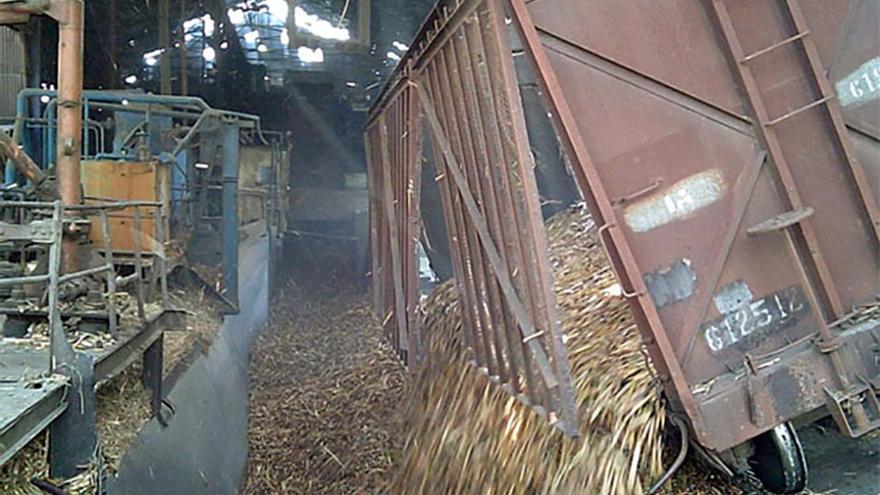
![]() 14ymedio, Havana, 2 September 2022 — The Cuban authorities have set themselves the goal for the next harvest at even fewer tons than were achieved in the previous one, which was the worst in the history of the Island. It’s true they have called it small, but it’s difficult to understand why they call it “efficient” since in no case does it even cover domestic demand.
14ymedio, Havana, 2 September 2022 — The Cuban authorities have set themselves the goal for the next harvest at even fewer tons than were achieved in the previous one, which was the worst in the history of the Island. It’s true they have called it small, but it’s difficult to understand why they call it “efficient” since in no case does it even cover domestic demand.
Julio Andrés García Pérez, the General Manager of Azcuba, a group of companies in charge of sugar production, announced that 455,198 tons of sugar must be produced for the ’family basket’, tourism, medicines, industrial production and exports. It’s too little sugar for so much demand, if we take into account that domestic consumption requires around a half million tons, and, last year, 411,000 tons were committed to foreign sales.
The plan wasn’t achieved last year, since 911,000 tons had been projected and barely 473,720 were obtained. This year, therefore, officials adjusted their forecasts according to the poor production recorded in 2022, and even a little less. The figure is more realistic, although it remains to be seen if it is reached, in the midst of the current economic and financial debacle, lack of fuel, blackouts and a planting that has already started badly.
The campaign will begin in mid-November, which on this occasion will involve 23 sugar mills. In the past there were 36, but only three fulfilled their production plans, according to the authorities, who already warned that for this year the number of sugar mills would be reduced to 26. In the end, the number is even more modest.
In the meeting held yesterday between the leadership of Azcuba and the Party leadership, García Pérez explained that “it’s a matter of planning the harvest so it’s objective, flexible and, although small, with good practices, concentrating resources in fewer sugar mills to achieve greater efficiency.”
Deputy Prime Minister Jorge Luis Tapia Fonseca, who emphasized “discipline,” recalled that this year “there will be no more subsidies for losses in the sector” and fiercely placed the responsibility on the workers, whom he asked to be aware of how much they will achieve each day, because “if the mill doesn’t mill, the economic results won’t be good.”
“Indicators of efficiency are the main weapons of this harvest, which will be the beginning of the recovery of sugarcane in the country,” said Tapia Fonseca, to the astonishment even of the readers of the official media, Cubadebate.
“One of the most serious problems we have is triumphalism, which then dissolves into sad realities,” says a commentator in the article, entitled “Cuba is getting ready for a small, but more efficient harvest.” And another spits out, “That title is repeated every year.”
Meanwhile, a reader who has reviewed the accounts of the previous campaign says regretfully: “That means that the sugar production in the next harvest (455,198 tons) will be lower than in the last (480,000 tons in round numbers, the lowest production in more than a hundred years). We keep moving forward like the crab. We are already announcing that we will break the record we had ’achieved’ in the last harvest. And when I woke up, the directives were still there.”
The warning has also caught the attention of the Spanish-based Cuban economist Elías Amor. “Knowing that the economic situation is very serious, they no longer try to hide the disaster but broadcast it before it happens, so that people can prepare. It’s a change of strategy that, in the case of sugar or blackouts, is now set,” he says. The expert describes the adjective “efficient” as “a macabre joke” for the coming harvest.
Elías Amor has dedicated numerous analyses to the resounding fall of the sugar industry, which has gone through times of glory. In 1959, Cuba had 156 operational factories that produced 5.6 million tons of sugar. During the years of the Soviet subsidy, although without reaching the mythical 10 million announced by Fidel Castro, record figures were reached that exceeded eight million tons in the best harvests, between 1970 and 1989.
The root causes of the debacle in recent years are, for the authorities, the lack of fuel, breakage in machinery and transport and industrial failures, in addition to the humidity of the fields and COVID-19. According to the economist’s analysis, the greatest burdens are the absence of financing (due to the lack of access to financial markets), the impossibility of attending to domestic consumption and the little technology available to obtain sugar production byproducts* – “which is where the profitable sugar lines are.”
These causes explain the failure of one of the industries that contributed the most money to Cuba in history, well ahead of tobacco, but there will also be consequences. The lack of sugar for export will prevent the much-needed acquisition of foreign currency, and its absence for the domestic market will force the State to spend amounts of money that it doesn’t have. Meanwhile, the street finds a new reason for discontent.
*Translator’s note: The four main byproducts of the sugarcane industry are cane tops, bagasse, filter muds and molasses.
Translated by Regina Anavy
____________
COLLABORATE WITH OUR WORK: The 14ymedio team is committed to practicing serious journalism that reflects Cuba’s reality in all its depth. Thank you for joining us on this long journey. We invite you to continue supporting us by becoming a member of 14ymedio now. Together we can continue transforming journalism in Cuba.
